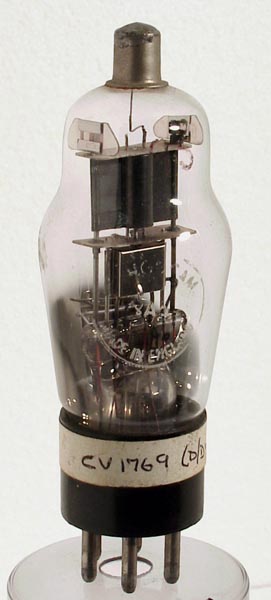|
2A6Sensibly equivalent¶ to:A4006B CV1769 PH2A6 UZ2A6
|
|
|

|
The 2A6 double diode triode is designed for detector and first audio stage in American radio receivers. The heater voltage of 2.5 Volts is unusual in the UK but a heater voltage of 2.5V was the original (late 1920s) standard for American indirectly-heated AC mains valves. The change to a 6.3V standard came about because of the demand (in the US) for car radios in the early and mid 1930s (most US cars at that time still had 6V electrical systems). The type 75 has the same UX6 base but a 6.3 Volt heater for this new market. Later the 6B6G was again the same valve but on an IO base and had a 6.3 Volt heater.This exhibit is a much later (post-War) replacement type branded Tungsram but probably factored. 2.5-volt valves were obsolete in the US by then but remained in demand for replacement purposes, eg. in South America. The interesting thing is that such a valve should have a CV number, particularly since it was essentially a US domestic radio type.The valve has a common cathode assembly, seen running vertically through the centre of the valve. The signal diode anodes are the bright plates seen in the centre of the envelope. Each side is insulated and forms a diode anode. The top of the electrode structure is the triode. The anode cavity is blackened.The classic envelope is 36 mm in diameter and, excluding the UX6 base pins, is 98 mm tall.References: Data-sheet, 1040, 1043 & 3002. Type 2A6 was first introduced in 1933. See also 1933 adverts. |
Pin Connections
| 1 | 2 | 3 | 4 | 5 | 6 | tc |  h | a | a(d2) | a(d1) | k | h | g1 |
|
|
Absolute Maximum Operating Conditions¶
| Vh | Ah | Va | Vg | mAa | ra | gm | 
| 2.5 | 0.8 | 250 | -1.35 | 0.4 | 91k | 1.1 |
|
Updated February 15, 2013.
|
|